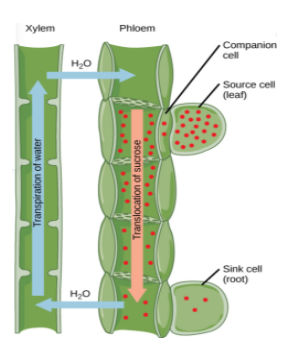
The living cells of phloem are
A. Phloem fiber
B. Companion cells
C. Sieve tube
D. Both B and C
Answer
494.7k+ views
Hint: In phloem both companion cell and sieve tubes are living cells.
These both have cytoplasm.
Complete answer: In plants phloem and Xylem are found as vascular bundles.
Phloem is responsible for the translocation of food.
Phloem includes four types of cells i.e. sieve tubes, companion cells, phloem fiber, and phloem parenchyma.
Phloem parenchyma has dense cytoplasm and a nucleus.
Sieve tubes have peripheral cytoplasm and large vacuole but lack a nucleus.
Phloem companion cells are parenchymatous and these have a nucleus.
These are also the living cells of phloem. Phloem fibers are dead. It has a thick wall and lacks a cytoplasm.

So, the correct answer is “Option Both B and C”.
Note: Sieve tubes lack nucleus. The function of the sieve tube is regulated by the nucleus of companion cells. Sieve tubs have the function for translocation of food in plants for this pressure gradient is maintained by companion cells so the companion cell helps sieve tubes in translocation of food.
These both have cytoplasm.
Complete answer: In plants phloem and Xylem are found as vascular bundles.
Phloem is responsible for the translocation of food.
Phloem includes four types of cells i.e. sieve tubes, companion cells, phloem fiber, and phloem parenchyma.
Phloem parenchyma has dense cytoplasm and a nucleus.
Sieve tubes have peripheral cytoplasm and large vacuole but lack a nucleus.
Phloem companion cells are parenchymatous and these have a nucleus.
These are also the living cells of phloem. Phloem fibers are dead. It has a thick wall and lacks a cytoplasm.

So, the correct answer is “Option Both B and C”.
Note: Sieve tubes lack nucleus. The function of the sieve tube is regulated by the nucleus of companion cells. Sieve tubs have the function for translocation of food in plants for this pressure gradient is maintained by companion cells so the companion cell helps sieve tubes in translocation of food.
Recently Updated Pages
Master Class 9 General Knowledge: Engaging Questions & Answers for Success

Master Class 9 English: Engaging Questions & Answers for Success

Master Class 9 Science: Engaging Questions & Answers for Success

Master Class 9 Social Science: Engaging Questions & Answers for Success

Master Class 9 Maths: Engaging Questions & Answers for Success

Class 9 Question and Answer - Your Ultimate Solutions Guide

Trending doubts
Draw ray diagrams each showing i myopic eye and ii class 12 physics CBSE

Why do the transition elements have higher enthalpies class 12 chemistry CBSE

What are the advantages of parallel combination over class 12 physics CBSE

What are the causes of overloading class 12 physics CBSE

How do you convert from joules to electron volts class 12 physics CBSE

There is hypertension due to smoking Give scientific class 12 biology CBSE




